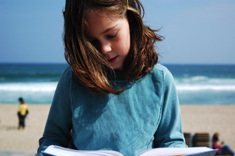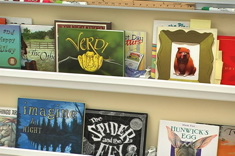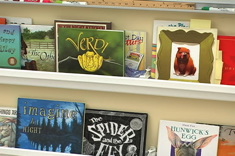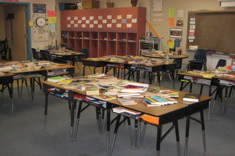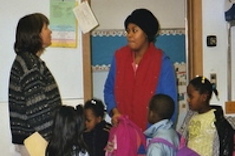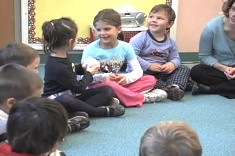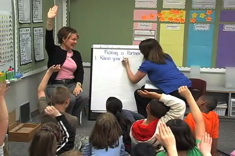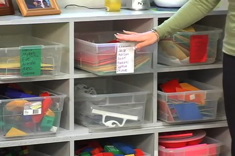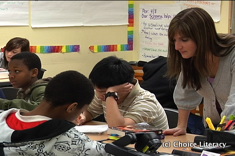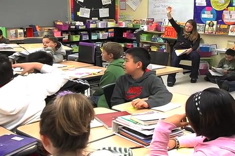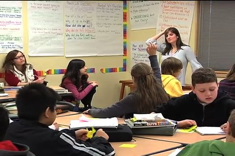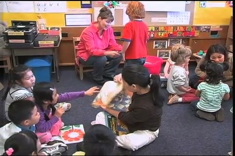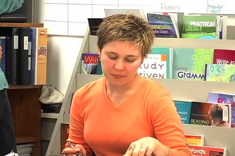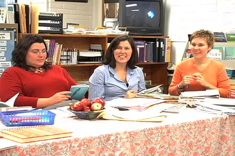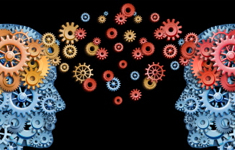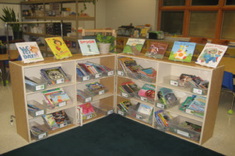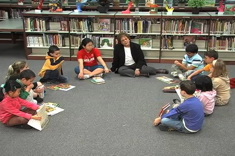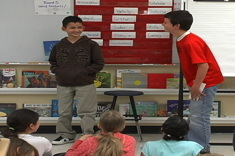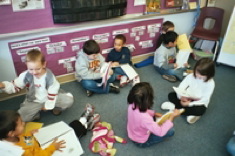Community Building
It's one of the big paradoxes of literacy instruction - students best learn how to read and write independently when they have a strong community of support in classrooms. How teachers build those thoughtful, kind, and challenging classroom communities is explained in these resources.
Latest Content
The Luxury of Extra Reading Time Over the Holidays
Franki Sibberson finds the days before holiday break are the perfect time for talking through with students how to make pleasure reading choices. Her feature includes a template to help students organize and think through their preferences.
Community First: Using Read Alouds to Strengthen Classroom Connections
Mary Lee Hahn plans her read alouds for double duty, using them to build the community and a love of reading.
Letters in the Middle School Classroom
First-year teacher Erin Ocon finds an old-fashioned way to build rapport with some of her struggling middle school students – she writes letters to them. This brief article would be a good reading for a middle school team meeting or new teacher group.
Inspiration from Author Visits: Tips and Web Resources
Jennifer Jones reflects on the power of a local author visit in her school, and also provides some quick tips and weblinks for planning a visit.
Read Our Walls: Bridging Professional Development and Student Achievement
Jennifer Allen and her colleagues knew test scores weren’t the only way of defining their students’ achievements and the value of their professional development program. “Read Our Walls” is an easy but powerful way to celebrate writing from the entire school community.
Easing into Assessments During the First Six Weeks of School
Franki Sibberson and Karen Szymusiak have suggestions for integrating observations and assessments of students naturally into reader's workshops during the first six weeks of school.
Supporting Readers During Workshops: The First Few Weeks
Katie DiCesare ponders the different ways students need to be supported in her primary classroom during the early days of the school year.
Letting Students Define and Design My 6th Grade Classroom Library
Katie Doherty's 6th graders take charge of the classroom library, with an activity designed to build an understanding of genre at the same time.
A Tornado of Books
By upending the classroom library and asking students to sort and reorganize it, Karen Terlecky gets insight every year into the ways students categorize texts, as well as their emerging understanding of genre.
Helping Classroom Volunteers Become Better Listeners
Helping volunteers understand the importance of listening to young learners is one of Andie Cunningham’s goals. Here she gives tips for preparing volunteers to confer with children.
Picture Books About Books: Young Learners and Reading Identity
Katie DiCesare gathers picture books to talk with her first graders about everything from reading identity to the proper care of books in the classroom library.
Got Space?
Jennifer Allen gets creative with space for displays in her literacy coaching work.
Morning Meeting in Kindergarten
Danielle French leads her kindergarten students in Waterville, Maine, during morning meeting. After the meeting, Danielle talks with “The Sisters” (Gail Boushey and Joan Moser) about the value of this daily routine.
Picking a Partner: Demonstration Lesson and Debrief
In this demonstration lesson from a K-2 classroom, Joan Moser leads students through guided practice in picking a partner.
Organizing for Independence: From Cubbies to Social Groups
In this brief video, Joan Moser talks about how she organizes student materials in "social groups" to avoid the use of desks or cubbies in her classroom.
Weekend Headlines: Introduction
In this first of a three-part video series, Katie Doherty and her sixth grade students begin the Weekend Headlines activity. Each Monday, students listen to Katie share some of the headlines from the local newspaper and then share their "headlines" from the weekend.
Weekend Headlines: Peer Response
In this second part of a three-part video series, Katie Doherty and her sixth grade students continue the Weekend Headlines activity. In this installment, Katie sets up a peer response procedure.
Weekend Headlines: Whole Class Share
In this final installment of a three-part video series, Katie Doherty and her sixth-grade students continue the Weekend Headlines activity. In this installment, students share their writing with the whole class and respond.
Many Languages, Many Texts: Book Time in Preschool
In this brief video, Melissa Kolb explains "Book Time" in her preschool class. It's a time when many volunteers read books informally to small groups of children in their home languages.
January New Teacher Group Update: When Life Happens
Preparing for a forced sick day with her daughter, Jennifer Allen is reminded that the culture of professional development in her school is something she can depend on.
New Teacher Conversations: Management Stories from the Classroom
Ruth Shagoury provides a workshop model for teacher leaders looking to encourage respectful conversation with new teachers on the topics that are near and dear to them.
Two or Three Things I Know for Sure: A Teacher Workshop Activity
"Two or Three Things I Know for Sure" is a terrific short workshop activity for study groups or faculty meetings, and it also can be used in partnership discussions with mentors, literacy coaches, and colleagues. The activity gets everyone to explore their bedrock beliefs about teaching – as well as what it takes to change them.
Writing Strengths Anchor Chart
Suzy Kaback's anchor chart activity builds a sense of community and peer editing connections in her middle school classroom.
Organizing Book Bins: Letting Kids Help and Plan
Katie DiCesare writes about how children can be enlisted to help in creating and organizing book bins in libraries. But in Katie's classroom, the process of matching books to children begins with "My Stack" – her pile of books that changes daily, linking individual children and texts of interest.
Tiger Teams: Mixed Age Student Groups
In this video, Karen Szymusiak (the principal at Glacier Ridge Elementary School in Dublin, Ohio) explains how “Tiger Teams” work. Tiger Teams are mixed age groups of K-5 students who meet regularly to talk about their learning and the school community.
The “All About Us” Board: Linking Literacy and Community Building All Year Long
Suzy Kaback has terrific tips for an ever-evolving “All About Us” bulletin board to use from the first day of school to the last.
Opinion Exchange (E-GUIDE)
How can quotes lead educators to awareness and acceptance of the diversity of opinions in a group? Discover what this format for discussion has to offer your study group or staff.
The Read-Around: Raising Writers
If there was a centerpiece to teaching writing that also brought students closer together, wouldn't you want to know about it? Read on about the Read-Around.
Mix It Up: Helping Young Writers Learn to Confer with Peers and Teachers
Ruth Shagoury models her own writing as a way to introduce the concept of conferring to young learners.
Poetry Friday! Poetry Books That Are Fun to Read Aloud
What do doughnuts and talk-filled mornings have in common? Learn about this Poetry Friday ritual that impacts independent reading time as well.
Browse Content By
Type
Category
- Assessment Tools
- Big Fresh Archives
- Booklists
- Choice Numeracy
- Classroom Design
- Common Core
- Community Building
- Conferring
- Content Literacy
- Digital Literacy
- English Language Learners
- Equity
- Family Relations
- Free Samples
- Guiding Groups
- Leadership
- Literacy Coaches
- Mentor Texts
- Minilessons
- New Teacher Mentors
- Podcasts
- Poetry
- Quote Collections
- Reading Strategies
- Self Care
- Struggling and Striving Learners
- Talking and Listening
- Teacher Study Groups
- Teaching Reading
- Teaching Writing
- Word Study and Vocabulary
Author
- Melissa Quimby
- Nawal Qarooni
- Gwen Blumberg
- Julie Cox
- The Lead Learners
- Hannah Tills
- Josie Stewart
- Ruth Metcalfe
- Mallory Messenger
- Becca Burk
- Jodie Bailey
- Vivian Chen
- Mary Brower
- Tiffany Abbott Fuller
- Stephanie Affinito
- Ruth Ayres
- Leigh Anne Eck
- Heather Fisher
- Shari Frost
- Julie Johnson
- Suzy Kaback
- Gigi McAllister
- Shirl McPhillips
- Melanie Meehan
- Cathy Mere
- Debbie Miller
- Tara Barnett and Kate Mills
- Tammy Mulligan
- Dana Murphy
- Bitsy Parks
- David Pittman
- Brenda Power
- Heather Rader
- Matt Renwick
- Mandy Robek
- Christy Rush-Levine
- Gretchen Schroeder
- Jen Schwanke
- Brian Sepe
- Katherine Sokolowski
- Stella Villalba
- Jennifer Vincent
Grade Level
Choice Literacy Membership
Articles
Get full access to all Choice Literacy article content
Videos
Get full access to all Choice Literacy video content
Courses
Access Choice Literacy course curriculum and training

